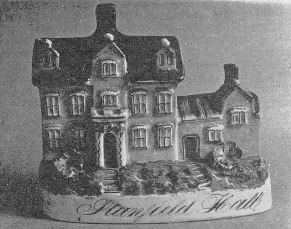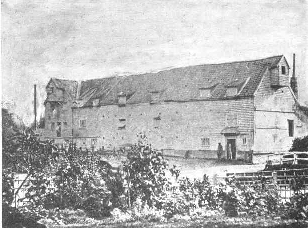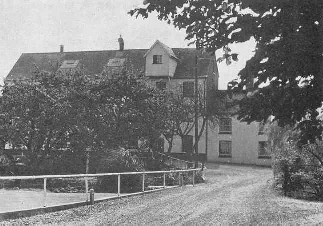
FAMILY MATTERS
I now turn to more intimate family matters, of which there are two of interest after Peter's marriage in 1837. The first is the Rush Murder of 1848 and the second is the sale of most of the Lenwade properties in 1853.
A great many of the present and immediately preceding generations have been brought up to regard the Rush Murder as "The Family Murder". I am sorry to disappoint many family readers but the Le Neve-Foster connection with this unpleasant affair is only a connection by marriage with one of the victims. The murder itself is one of the most sensational crimes ever perpetrated in Norfolk and ranks with the "Murder of Maria Martin in the Red Barn" at Polstead, in Suffolk, in the annals of East Anglian crime.
The Rush Murder
The details of the murder and the events leading up to it are the subject of a book of some 270 pages in the Notable British Trial series and I can only summarise them here. John Blomfield Rush was the illegitimate son of a gentleman farmer near Wymondham, in Norfolk, and became steward and agent for the Rev. George Preston, the owner-occupier of Stanfield Hall, about two miles from this little market town. Preston's title to the property was a matter of dispute with some relatives, the Jermy family, and when Preston's son, Isaac, inherited Stanfield Hall he immediately petitioned Queen Victoria and the Earl Marshal for permission to adopt the name and arms of Jermy. The petition was granted (the actual grant is a very long and pompous document) and though Isaac Preston now became Isaac Jermy, his change of name did not end the disputed title to Stanfield. Isaac, however, together with his son, Jermy Jermy and his daughter-in-law (née Sophia Jane Chevallier) continued to live there.
Isaac Jermy had not the same confidence in J. B. Rush as his father had had. A quarrel ensued and Rush ceased to be steward, though he did continue to occupy Potash Farm about a mile away from Stanfield. Rush now got into financial difficulties and proceeded to forge documents and add forged signatures to others which, if the Jermys (formerly Prestons) were out of the way, might well put him into the position of a very favoured tenant of the other branch of the family, which would be likely to inherit.
The position on the 28th November 1848-the date of the murder-was briefly this:
Rush was in financial difficulties.
He possessed forged documents, which would be likely to ease his precarious financial position if the Jermys (Prestons) were out of the way.
He detested the elder Jermy as a result of losing his job as steward.
On the evening of the 28th November Rush went to Stanfield Hall armed, as was afterwards discovered, with a blunderbus. He shot and killed the elder Jermy on the front porch and his son in the passage outside the library. He then shot at young Mrs. Jermy and wounded her so badly that she subsequently had to have her arm amputated. After that he shot at the housemaid, Eliza Chastney, who ran to help her mistress, and wounded her in the thigh. The housemaid recovered sufficiently to give evidence at Rush's trial but Mrs. Jermy was not called as a witness.
Rush was arrested at Potash Farm next day, charged with murder and tried at the Norwich Assize, the trial lasting from the 28th March to 6th April 1849. Rush refused to be represented by counsel and conducted his own defence, but after the Judge's summing up the jury was only absent for ten minutes before bringing in a verdict of "Guilty", a verdict with which anyone who studies the trial would certainly agree.
Rush was publicly executed outside Norwich Castle on 21st April 1849 before a crowd of some 13,000 people, including a woman who rose from her bed within an hour and a half of giving birth to a child and walked six miles so as not to miss the event. A further addition to the crowd travelled from London on a special train, but the police stopped the train at Attleborough and turned its occupants back.
The family connection with these exciting but unpleasant events is through young Mrs. Jermy, the lady who lost her arm, who was Sophia Jane Chevallier and a sister of Georgiana Chevallier, Peter Le Neve-Foster's wife.
It would appear that the Jermy and Le Neve-Foster families knew each other very well. The elder Jermy was a barrister and became Recorder of Norwich in 1831, so that a friendship with Peter Le Neve-Foster, a barrister pleading in the Norwich courts, would not be surprising. Peter's diary contains some references to Wymondham, but not specifically to Jermy or Stanfield. A further sidelight is that when the murder took place a telegram was sent to the Le Neve-Fosters who were then living in Camberwell. Peter immediately set off for Norfolk but before leaving is reputed to have said, "I will write down the name of the man who has done this" and wrote the name of J. B. Rush whom he had apparently always distrusted. These facts all support the theory that the two families were on friendly terms as well as being related by marriage.

Staffordshire Pottery model of Stanfield Hall, probably made about the time of Rush's trial.
Mrs. Jermy subsequently remarried and became Lady Beevor. Rush's death mask is preserved in the Castle Museum in Norwich and there is a wax effigy of him in the Chamber of Horrors at Madame Taussaud's. History does not relate what happened to Eliza Chastney, the housemaid who was shot in the thigh, but one hopes that Lady Beevor made sure that she wanted for nothing. So much for the "Family murder".
Sale of the Lenwade Properties
To turn to more domestic matters, Peter was not particularly well off, especially as he had ten children to educate. He also had certain responsibilities to his mother and sisters. Under the terms of his father's will Peter was to inherit the White House after his mother's death, when he was to become responsible for paying certain legacies to his sisters Grace and Belle. When his mother died in 1835 and the estate was settled it turned out that there was not enough money to pay the legacies in full and Peter had this financial millstone round his neck for the rest of his life. Even though Grace and her husband were quite well off they insisted on the letter of their financial rights to the considerable, embarrassment of Peter and his large family, who nicknamed John Nunes "Uncle Glue", presumably because he stuck to the money. Even after Peter's death in 1879 his widow had to continue making payments to Grace and in order to make ends meet she had to work as a translator, and amongst other things made a French translation of Herbert Spencer's philosophical works. She was well fitted for this kind of work as her father was the Rev. C. Chevallier, Fellow and Tutor of Pembroke College, Cambridge, and a Chancellor's Medallist. Georgiana herself was both a French and a Latin scholar. She was helped in her French translation work by two of the children, Oliver and Mary.

Lenwade Mill from a photograph taken towards the end of the last century, probably between 1880 and 1890.

Lenwade Mill from a photograph taken by the author in 1969.
After his mother's death in 1835, Peter let the White House to his aunt, Mrs. Leeds (née Eliza Le Neve-Foster) but in 1853 most of the property, including the White House itself, was sold. I have the auctioneer's announcement of the sale and a map of the property. The freehold and leaseholds, which were sold, were:
Lenwade Water corn mill.
215 acres of arable land with farm buildings.
The White House.
Six cottages.
Lenwade Bridge Inn.
The mill is described as "a water corn mill" and the announcement goes on to say ". . . the water wheel drives nine pairs of four foot stones. . ." a fair sized mill for the time I think. There are marginal notes of some of the prices fetched, for example, the Bridge Inn went to Bullards, the Norwich brewers, for £655.
The sale of 1853 was not quite the end of the family connection with Lenwade as I have details of another sale of some further property in 1885. I think this second sale must have been in connection with Georgiana's estate, as she died in that year. The property sold on this second occasion consisted of a dwelling house, a blacksmith's shop, a well and two water closets. Knowing the domestic drainage system of rural East Anglia even in 1966, I tremble to think what may have seeped into the Lenwade well in 1885.
There must also have been some other property as Peter's youngest daughter; Mary Le Neve-Foster ("Aunt Mary") sold a small house in Lenwade in 1918.